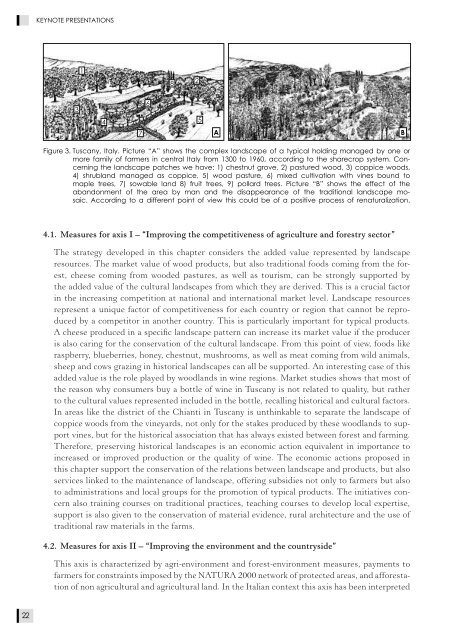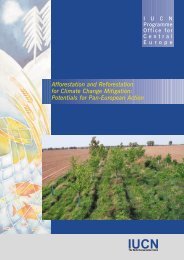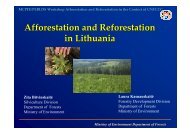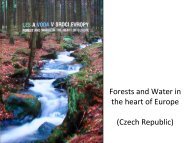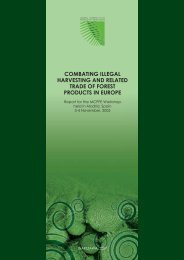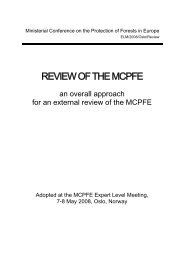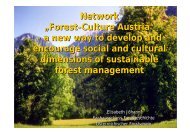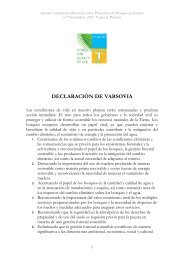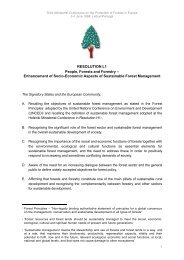Volume 1 - Forest Europe
Volume 1 - Forest Europe
Volume 1 - Forest Europe
You also want an ePaper? Increase the reach of your titles
YUMPU automatically turns print PDFs into web optimized ePapers that Google loves.
22<br />
KEYNOTE PRESENTATIONS<br />
3<br />
1<br />
4<br />
7<br />
6<br />
8<br />
Figure 3. Tuscany, Italy. Picture “A” shows the complex landscape of a typical holding managed by one or<br />
more family of farmers in central Italy from 1300 to 1960, according to the sharecrop system. Concerning<br />
the landscape patches we have: 1) chestnut grove, 2) pastured wood, 3) coppice woods,<br />
4) shrubland managed as coppice, 5) wood pasture, 6) mixed cultivation with vines bound to<br />
maple trees, 7) sowable land 8) fruit trees, 9) pollard trees. Picture “B” shows the effect of the<br />
abandonment of the area by man and the disappearance of the traditional landscape mosaic.<br />
According to a different point of view this could be of a positive process of renaturalization.<br />
4.1. Measures for axis I – “Improving the competitiveness of agriculture and forestry sector”<br />
The strategy developed in this chapter considers the added value represented by landscape<br />
resources. The market value of wood products, but also traditional foods coming from the forest,<br />
cheese coming from wooded pastures, as well as tourism, can be strongly supported by<br />
the added value of the cultural landscapes from which they are derived. This is a crucial factor<br />
in the increasing competition at national and international market level. Landscape resources<br />
represent a unique factor of competitiveness for each country or region that cannot be reproduced<br />
by a competitor in another country. This is particularly important for typical products.<br />
A cheese produced in a specifi c landscape pattern can increase its market value if the producer<br />
is also caring for the conservation of the cultural landscape. From this point of view, foods like<br />
raspberry, blueberries, honey, chestnut, mushrooms, as well as meat coming from wild animals,<br />
sheep and cows grazing in historical landscapes can all be supported. An interesting case of this<br />
added value is the role played by woodlands in wine regions. Market studies shows that most of<br />
the reason why consumers buy a bottle of wine in Tuscany is not related to quality, but rather<br />
to the cultural values represented included in the bottle, recalling historical and cultural factors.<br />
In areas like the district of the Chianti in Tuscany is unthinkable to separate the landscape of<br />
coppice woods from the vineyards, not only for the stakes produced by these woodlands to support<br />
vines, but for the historical association that has always existed between forest and farming.<br />
Therefore, preserving historical landscapes is an economic action equivalent in importance to<br />
increased or improved production or the quality of wine. The economic actions proposed in<br />
this chapter support the conservation of the relations between landscape and products, but also<br />
services linked to the maintenance of landscape, offering subsidies not only to farmers but also<br />
to administrations and local groups for the promotion of typical products. The initiatives concern<br />
also training courses on traditional practices, teaching courses to develop local expertise,<br />
support is also given to the conservation of material evidence, rural architecture and the use of<br />
traditional raw materials in the farms.<br />
4.2. Measures for axis II – “Improving the environment and the countryside”<br />
2<br />
5<br />
A<br />
This axis is characterized by agri-environment and forest-environment measures, payments to<br />
farmers for constraints imposed by the NATURA 2000 network of protected areas, and afforestation<br />
of non agricultural and agricultural land. In the Italian context this axis has been interpreted<br />
B


